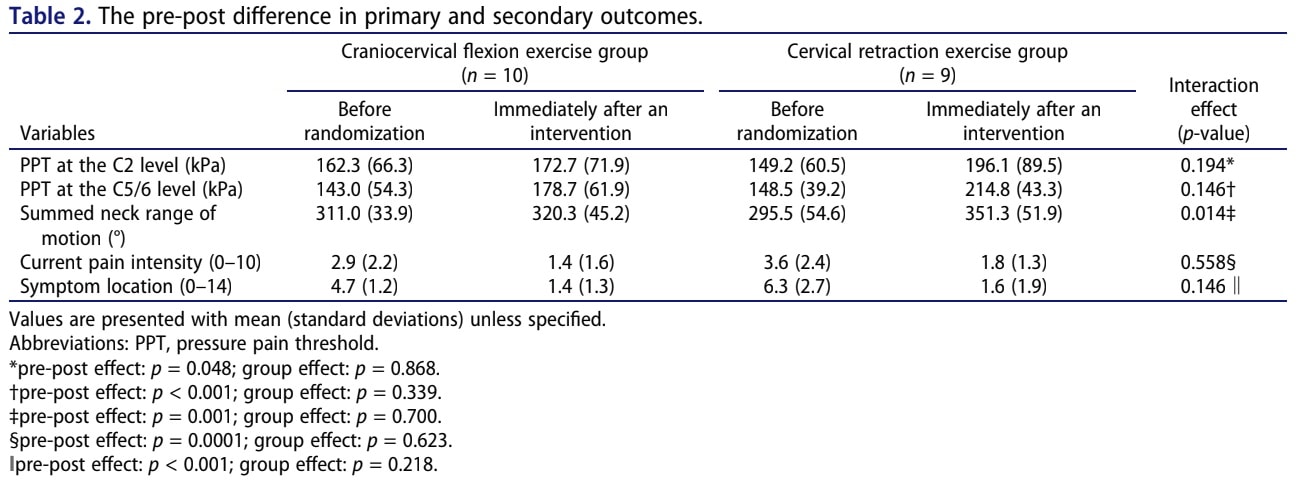Comparing Cervical Retraction Exercises to Craniocervical Flexion Exercises in Neck Pain

Introduction
Deep neck flexor exercises have been demonstrated to be successful in treating neck discomfort and improving neck function. Poor performance on the craniocervical flexion test is linked to dysfunction of the deep cervical flexor muscles. Deep neck flexor exercises were shown to outperform other kinds of exercise in terms of pain, disability, and range of motion (ROM). With the local analgesic effects it can exert in people with neck pain, it is an efficient strategy to empower someone with neck complaints.
Some patients find it however difficult to accurately perform this type of exercise. Especially at home, when they don’t have you to guide them to selectively activate the deep neck flexor muscles without compensating in other muscles. The authors of the current study proposed performing cervical retraction exercises as these create the largest amount of upper cervical spine flexion. They expected that this would lead to larger deep neck flexor activation than the cervical flexion exercises, with a lower load. Therefore, this review dives deeper into cervical retraction exercises in neck pain.
Methods
A two-arm pretest-posttest randomized experimental study design was set up to recruit subjects with neck pain and a Neck Disability Index score of more than 16%. The main intervention comprised a session performing cervical retraction exercises. These were performed for 3 minutes per set for a total of 3 sets. Participants were seated upright and gently self-applied overpressure at the end range of the cervical retraction exercise.
The control group performed craniocervical flexion exercises supine with the knees flexed. These exercises were performed with the use of a pressure feedback device. Using the known levels of 22, 24, 26, 28, and 30 mmHg.
Hypoalgesia, measured with pressure pain threshold measurement algometry was the outcome of interest. This was assessed between the occiput and the spinous process of C2 as well as on the C5-C6 facet joint. The measurements were obtained before randomization and immediately after the intervention.
Results
A total of 20 participants were included in this study and randomized to the intervention group performing cervical retraction exercise or to the control group who performed deep neck flexor exercise. They differed statistically significantly on the 4-item pain intensity measure at baseline. No statistically significant difference was found at baseline for symptom duration, yet when looking at the mean duration, this was almost double in the cervical retraction exercise group.

The analysis found significant pre-post effects in the primary outcome pressure pain threshold, in both groups. Besides the improvement in the primary outcome, significant pre-post effects were also observed in the secondary outcomes neck ROM, current pain intensity, and symptom location. A statistically significant interaction effect in neck ROM was also seen. No group effects were observed.

Questions and thoughts
The authors indicated that the group performing cervical retraction exercises had greater improvement in hypoalgesia and neck ROM. This is true when looking at the within-group change. Yet, no between-group difference was observed. Both groups improved but none of the interventions was superior. The purpose of this study was to compare the 2 interventions against one another. As such, the within-group change is not to be used to rate the effectiveness of the interventions.
The within-group analysis showed that both groups had improved pain intensity and pain location with only 1 session performed for 9 minutes, so it appears that both interventions could be beneficial.
Cervical retraction exercises were found to produce a significant interaction effect for ROM with a large effect size. Cervical retraction exercise provided a greater percentage of improvement with a large effect size (g = 1.259) compared with craniocervical flexion exercise. This was a secondary outcome measure and the interpretation of this finding should be further investigated.
Talk nerdy to me
It seems reasonable to investigate the effect of cervical retraction exercises. When you retract your neck, you will automatically also flex the upper cervical spine, and thus use the deep cervical neck flexor muscles.
The authors, however, point to the use of retraction exercises for derangement syndrome in those with a directional preference for cervical extension from the McKenzie method. Then, in the methodology, the authors include patients with a directional preference for extension. However, they stated: “Because symptoms may change during the process of diagnosing the derangement syndrome, confirmation of the derangement syndrome cannot be included in the inclusion criteria before data collection and the diagnosis had to be made after data collection completion.” This is an issue because they’ll only include those who are more likely to respond to treatment. Of course, then, they are likely to be better when performing the cervical retraction exercises. It would be like evaluating a new test for ACL tears but first excluding all those who had a negative Lachmann for example.
Whether there were people better responding to the cervical retraction exercises should have ideally been tested in a subgroup analysis.
Take home messages
This was a small preliminary pretest-posttest randomized controlled trial. The results indicated that the group doing the cervical retraction exercise could have potentially better effects compared to the group performing the deep neck flexor exercises. However, this reflected the within-group change over time and was not the aim of the study. It appears that both interventions are effective in improving pain in people with neck pain.
Reference
100% FREE HEADACHE HOME EXERCISE PROGRAM
Download this FREE home exercise program for your patients suffering from headaches. Just print it out and hand it to them for them to perform these exercises at home



